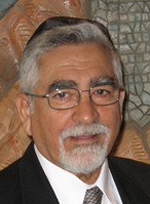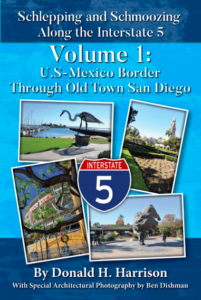By Dorian de Wind

AUSTIN, Texas — According to Google Maps, the distance between San Ysidro, Calif., and Exit 18B off the Interstate 5 (the exit to reach the San Diego Sheriff’s Museum in Old Town San Diego) is 18 miles and, under normal traffic conditions, would take about 20 minutes — that is, without taking any of the 20 or so exits in between.
However, doing so would deprive the driver and his or her passengers the pleasure (and education) of taking in scores of the most beautiful, interesting, and historic places and locations in the greater San Diego area.
Equally important, one would miss learning about nearly two centuries of accomplishments and cultural, societal, economic, scientific, and political contributions made by Jewish people to San Diego, San Diego County, and the nation.

Thanks to Donald H. Harrison’s newest book, Schlepping and Schmoozing Along the Interstate 5, we can, without enduring California traffic and drivers, take every Interstate 5 exit between the U.S.-Mexico border and the above-mentioned Sheriff’s Museum and discover the impact Jewish people, religion, and culture have had on this part of California.
Harrison, former co-publisher and editor of San Diego Jewish World and now editor emeritus, has coined the phrase “there is a Jewish story everywhere” for his journal.
Volume 1 of his book (spanning the U.S.-Mexico border through Old Town San Diego) more than confirms the veracity of the saying. As it turns out, there is at least one fascinating Jewish story at every Interstate 5 exit — sometimes three, four, or more.
The book is the result of several years of research, interviews, travel, and reporting Harrison has done to learn about and document Jewish history, tradition, and life in Southern California.
Even before crossing the U.S.-Mexico border and picking up Interstate 5 at San Ysidro, Harrison introduces us to Mexican Jews living, working, and practicing Judaism in Tijuana, Baja California, Mexico.
From then on, the stories only get more in-depth and more interesting.
Already at the very first exit, at Las Americas Premium Outlets, we learn about the business savvy and entrepreneurial spirit of Jewish men and women, such as the brothers Melvin and Herbert Simon. Sons of an immigrant tailor from Central Europe, the brothers went on to develop the Simon Properties Group, “the largest shopping mall operator in the U.S.” Together and separately the Simon brothers would go on to become extremely successful entrepreneurs and generous philanthropists.
We see many more Jewish success stories at every exit.
Take for example, at exit 5A, the magnificent Loews Coronado Bay Resort, just one of the worldwide properties of the Tisch family Loews properties and part of the family’s sprawling, multi-billion-dollar business empire. Again, we learn of Jewish hard work, ingenuity, business savvy, and unrivaled philanthropy.
In fact, at the same exit and just four miles past Coronado Bay, one arrives at San Diego’s legendary — now a national historic landmark — 757-room, Victorian era, beachfront Hotel del Coronado (“Hotel Del”), at one time owned by M. Larry Lawrence, a respected member of the Jewish community.
Harrison provides intimate details (including many little-known facts) on some of the Del’s most famous guests. A guest list that included 11 U.S. presidents, British royalty, movie and recording stars, and many other celebrities. Harrison focuses on the welcome fame and glamor Jewish-converted Marlyn Monroe brought to the Del.
But he also writes about the not-so-welcome notoriety eventually attached to King Edward VIII, who had stayed at the Del in 1920 as the young Prince of Wales.
The Del initially promoted the romantic story that it was at the hotel that the Prince first caught a glimpse of Wallis Simpson, his future wife. Eventually this association with the hotel was downplayed after historians profiled Edward VIII as “a covert Nazi sympathizer.”
We see a similar “change of fortunes” occur at the interstate’s off ramp to what used to be known as Lindbergh Airport, named after the famous aviator Charles Lindbergh (“The Spirit of St. Louis”). The name was changed to San Diego International Airport after Lindbergh’s admiration for Adolf Hitler, his affinity for “eugenics” and other not-so-patriotic tendencies became widely known.
After taking Exit 7B, we get an insight into the Orthodox mikvah (ceremonial conversion bath), but also on how it is done today at Bayside Park, Chula Vista, and at nearby temples (“nudity is not required”). We also get a glimpse into another step in the conversion process, the beth din — questions posed by three (ordained) rabbis: How it was done in the time of Emperor Constantine (perhaps how “it should not be done”) and how George Carbajal, a descendant of Portuguese Sephardic Jews living in San Diego, did it 2,000 years later.
Need more Jewish tidbits? Just take the next exit and pay a brief visit to Temple Beth Shalom, where Rabbi Michael Leo Samuel leads congregants through bar mitzvahs, marriage, shiva (the seven days of mourning), and other Jewish “life cycle events” such as brit milah (ritual circumcision). On the latter, the author assures us, “…many [adult males] who have gone through with it say it is not as painful.” Comforting words for this octogenarian reviewer, should he decide to…
Rabbi Samuel at Temple Beth Shalom is a prodigious author of books on Jewish religion and a scholar on Jewish ethics, philosophy, and social issues. Topics which the rabbi discusses at length with the author, in particular the rabbi’s views on early, influential Jewish philosophers and Torah scholars such as Philo and Maimonides. This alone is a fascinating read.
Paraphrasing Harrison, “there is a Jewish story for everyone.”
If you are into sports, just take the J street Exit (15B) and make your way to Petco Park, home of the legendary San Diego Padres baseball team, a Major League team that in turn has been home to 11 Jewish players and two Jewish coaches. In this chapter, Harrison summarizes the Jewish life stories of five of these men.
A military buff? Visit Naval Base San Diego and General Dynamics NASSCO.
At Naval Base San Diego, you will see docked (if in port) the Navy warship USS Gabrielle Giffords named after the brave, Jewish congresswoman who survived an assassination attempt. Harrison narrates in detail the congresswoman’s life, business, and political careers along with a description of the naval base’s history and missions.
Similarly, at General Dynamics NASSCO, another Navy ship — the USNS Harvey Milk — was built and recently launched in honor of the famous Jewish politician and tireless fighter for LGBTQ rights, whose life was tragically cut short by an assassin in 1978. For his story, take Exit 13B.
There are just too many gems of Jewish stories to even attempt to list here.
Suffice to say, whether the reader’s interests are Jewish religion or Jewish contributions in the areas of music, art, science, business, industry, education, literature, entertainment, journalism, politics — you name it — there is an “exit” for him or her in Schlepping and Schmoozing along the Interstate 5.
And we cannot omit Harrison’s own contributions, which he modestly and with humor incorporates into his book. Such as in the chapter describing how he, as the San Diego mayor’s press secretary, deftly handled what became a major perceived “faux pas:” The mayor accidentally touching Queen Elizabeth II of England during her 1983 visit to San Diego — the first reigning British monarch to visit the city.
Finally, at the next-to-the last Interstate 5 exit in the book, Harrison describes how his own personal entrepreneurial contribution to San Diego began to take shape in 1989 when he started the Old Town Trolley Tours of San Diego.
To this day, the Old Town trolley is still the best way to take in the Jewish and all other sights in Old Town San Diego after exiting Interstate 5 at the Pacific Highway, then bearing right.
*
Dorian de Wind is a retired U.S. Air Force officer and a writer.